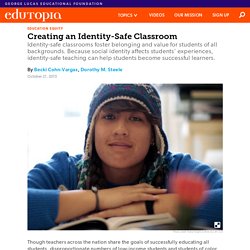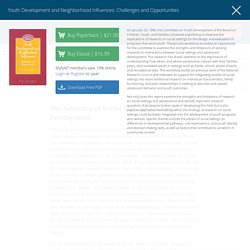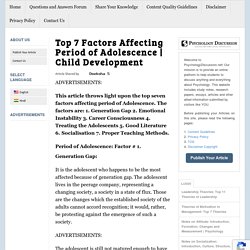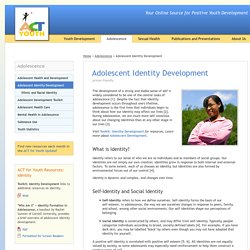

Teaching Strategy: Identity Charts. Creating an Identity-Safe Classroom. Though teachers across the nation share the goals of successfully educating all students, disproportionate numbers of low-income students and students of color are pushed out and fail to graduate.

So what prevents us from meeting each student's educational needs? We propose that one barrier is educators who often don't recognize the link between students' social and cognitive development, and that without addressing each student's needs for belonging and value, we cannot successfully teach them.
Our thinking is based on the assumption that teachers want the best for students and seek to be fair. Often they try to be colorblind, inadvertently creating an unsafe environment. When teachers don't pay attention to who each student is by failing to address his or her particular experiences and background, they unintentionally convey that what students know and can do, and how they feel, doesn't matter. An Alternative to Colorblindness Domains of Identity Safety 1. 2. 3. 4. Youth Development and Neighborhood Influences: Challenges and Opportunities.
Differences in Developmental Pathways One research study on youth has identified three key developmental tasks that characterize the period between early and late adolescence, ages 12 to 19 (Connell et al., 1995): learning to be productive, learning to connect, and learning to navigate.

The participants indicated that, although these three tasks may be central to successful adolescent development, variations in experience and circumstances can influence their timing, sequencing, and relative importance at any given time. Participants observed that prevailing views of adolescent development and conceptual frameworks derived from white, middle-class adolescent populations may not reflect the experiences or unique challenges that confront youth who are influenced by other cultural traditions or by disadvantaged conditions. The Impact of Settings on Role Expectations. A Tale of Two Teachers. African Storybook. Top 7 Factors Affecting Period of Adolescence. This article throws light upon the top seven factors affecting period of Adolescence.

The factors are: 1. Generation Gap 2. Emotional Instability 3. Career Consciousness 4. Treating the Adolescents 5. Period of Adolescence: Factor # 1. Generation Gap: It is the adolescent who happens to be the most affected because of generation gap. The adolescent is still not matured enough to have developed his own personality to assert his views or attitudes. And, the adolescent is the worst prey of this struggle. Stone et al, and Hopkins have shown how the adolescents gradually cease to be “parent-oriented” and shift into “peer-orientation”; and a clash ensues between the society of the adults and the society of the adolescents.
I am ... I am not ... Teens' Identity. Social Identity Wheel – Inclusive Teaching. Overview The Social Identity Wheel worksheet is an activity that encourages students to identify social identities and reflect on the various ways those identities become visible or more keenly felt at different times, and how those identities impact the ways others perceive or treat them.

The worksheet prompts students to fill in various social identities (such as race, gender, sex, ability disability, sexual orientation, etc.) and further categorize those identities based on which matter most in their self-perception and which matter most in others’ perception of them. The Social Identity Wheel can be used in conjunction with the Personal Identity Wheel to encourage students to reflect on the relationships and dissonances between their personal and social identities. The wheels can be used as a prompt for small or large group discussion or reflective writing on identity by using the Spectrum Activity, Questions of Identity. Activity Goals: Application in a STEM Course: Rhode Island Student Assistance Services.
Angela Oswalt Morelli , MSW, edited by C.

E. Zupanick, Psy.D. According to Erik Erikson, a prominent developmental theorist of the 1950's, youth must resolve two life "crises" during adolescence. Unlike many other developmental theorists of his era, Erikson's psychosocial theory of human development covers the entire lifespan, including adulthood. Erikson used the term "crisis" to describe a series of internal conflicts that are linked to developmental stages. Twelve Talks. Identity development is a central task of adolescent development. Who am I? How do I fit in? What is my role? What do I believe in? These are all key questions adolescents are asking themselves. During adolescence, teens are much more self-conscious about their changing identities than at any other stage in their lives. Many teens use their body as a form of self-expression, which can include how they dress and use make-up, hairstyles or hair colors, jewelry, accessories, piercings and tattoos.
I was just reading about “identity.” Conversation starters Bring up current events with your teen. Tell your teen your stories about your family, your experiences, your history, challenges you faced, a time you stood up for yourself, etc. Notice their relationships with adult role models. Adolescent Identity Development - Adolescence - ACT for Youth. The development of a strong and stable sense of self is widely considered to be one of the central tasks of adolescence [1].

Despite the fact that identity development occurs throughout one's lifetime, adolescence is the first time that individuals begin to think about how our identity may affect our lives [2]. During adolescence, we are much more self-conscious about our changing identities than at any other stage in our lives [3]. Visit Toolkit: Identity Development for resources. Learn more about Adolescent Development. Sense of identity during adolescence.